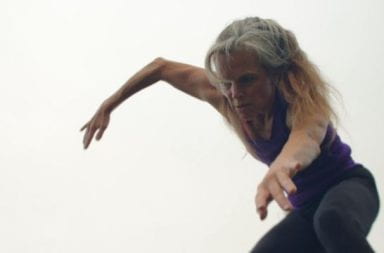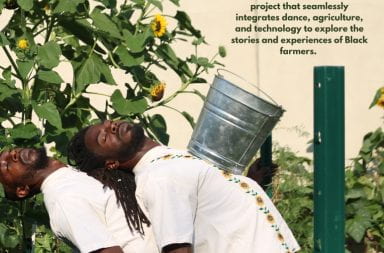
Roger Beebe, an experimental filmmaker and associate professor of art, displays a film reel in his office. Credit: Andrea Oh | Lantern Reporter
Filmmaker and associate professor of art Roger Beebe will be showing his experimental projector performances Tuesday at the Wexner Center for the Arts.
His films overlay various moving images on one screen, using 16mm and super 8mm projector films. Beebe’s screenings will work like performances as he works the reels during the showing.
Beebe will screen two of his newest projects as surprise showings, both of which are still in the process of being edited as of last week. Tuesday will be the first time the films are shown publicly.
“One of [the films] is really exciting for me in relation to the conversation about film versus the digital,” Beebe said. “What I’m going to do for the Wexner Center is try to think about the space of the desktop as a performance space in the same way that I’m thinking about the room.”
Other projects will be better known, such as “Amazonia,” a multi-projector performance that explores Amazon’s distribution centers, and “Soundfilm,” a 16mm film that explores the history of sound recording.
Beebe has shown his work globally, from places like McMurdo Station in Antarctica to New York’s CBS Jumbotron in Times Square.
He has been challenging the norms of film and moving images for 23 years, after initially taking a French New Wave film class during his sophomore year at Amherst College in 1990. His interest led him to study abroad and become an avid watcher of 1960s European art cinema with his friends.
Beebe never knew that film would be so important to him.
“What is film made of?” Beebe said. “It’s light. It’s duration. It’s this rectangle in this certain shape, and there’s a really weird … element in me that can dive down that rabbit hole and forget the world exists to just think about what happens inside of those rectangles.”
Throughout his career, Beebe has experimented with using projectors as a medium.
“I was really interested in something direct and something immediate and something that I could do without having to wait for funding,” Beebe said. “I moved toward a kind of filmmaking that I could do alone.”
After being hired to perform a show at a planetarium in 2008, Beebe knew he wanted to continue using projectors in his filmmaking.
“I built a bunch of abstract loops of nebula and what I called space-birds,” Beebe said. “When I showed that film, it was the most enthusiastic response I’d every gotten for anything I’d ever shown, so I knew that this is it. This is the thing.”
Beebe instills the same wonder for film within his students, especially within the moving-image production major, where he teaches Filmmaking Foundations 1.
“He really brings to light how filmmaking started … and filmmaking as an actual, physical object,” said Christopher Summers, media manager for Ohio State’s Department of Dance. “That really inspires his students how to think about film … and the physicality of filmmaking.”
The major is a new program that started Autumn Semester and is designed for students to get hands-on experience creating new work and understanding filmmaking from various perspectives.
For Beebe, the classroom becomes a laboratory for ideas, where techniques emerge from exploring new concepts and playing around with his students.
“[Beebe] makes you appreciate filmmaking, for making moving images, because … he really gets you to experiment with the world around you,” Summers said.
Beebe’s curiosity for the world and desire to challenge his limits radiates throughout his personal life and teaching.
“He wants you to get out there, get your hands dirty, get the film dirty and try new things,” Summers said.
The event will take place 7 p.m. Tuesday at the Wexner Center for the Arts. Admission is $6 for students and $8 for the general public.


